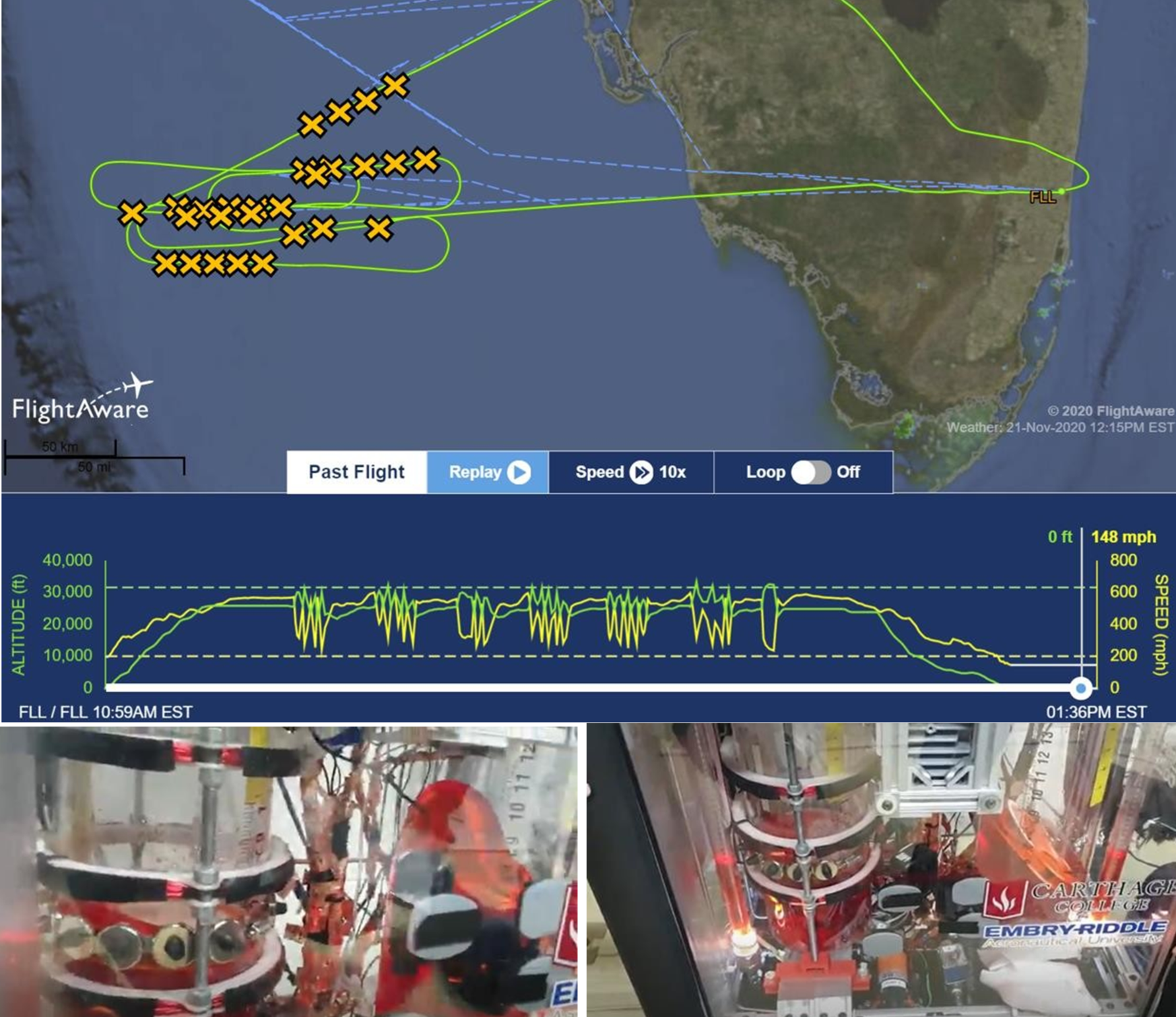181-189 of 189 results
-
Integration of the Emerging Space Ecosystem into the National Airspace System (NAS): Simulation and Analysis of Impacts and Solutions, NASA Florida Space Grant Consortium
CO-I Maxwell Cannon
CO-I Noah Eudy
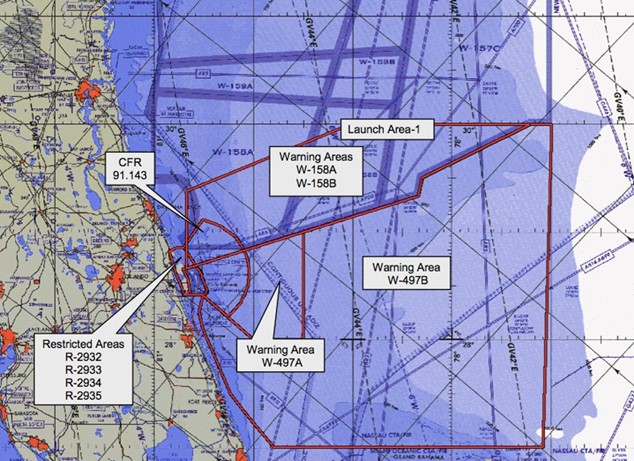
Currently, there is limited, but ongoing, simulation research on the integration of space operations into the NAS that focuses on impacts to other constituents and in finding solutions (cf, Tinoco, et al., 2019; Colvin & Alonso, 2015). Particularly, academic research based on modeling and simulation is quite minimal. Thus, the first objective of this research was to continue our current efforts and develop additional simulation models to analyze the potential impacts of launch and re-entry activities on key NAS stakeholder operations, particularly those of airlines, but also general aviation. NASA KSC/Cape Canaveral Air Force Station (CCAFS) clearly play a critical role in both the state of Florida and in our nation’s space ecosystem. As such, our area of interest was defined as Cape Canaveral, Florida. We built on our previous simulation research that centered on horizonal take-off and landing of Concept Z reusable launch vehicles (RLV) at Cecil Air and Space Port in Jacksonville, FL (cf, Tinoco et al (2019); Tinoco et al, pending) and our understanding of air traffic routes on the heavily traveled Eastern Seaboard.
Particularly in the United States (U.S.), the number of spaceports is growing as both public and private entities are examining commercialized space transportation as a means of revenue and economic growth. Conversely, stakeholders that lie outside the space industry, such as those in our nation’s aviation sector, view space transportation with caution, concerned about the negative effects on their own operations as space launch and return activities become the norm rather than the exception. These non-space stakeholders will directly and indirectly impact the pace and development of the U.S. space economy. Thus, safe, equitable, efficient and effective integration of space activities into the NAS is critical to all stakeholders, influencing the realized economic and non-economic benefits that these stakeholders aspire. Clearly, the new space economy will ultimately profit us all as a nation. However, this new path of growth must be examined through multiple lenses in order to achieve maximum benefit for everyone. As such, our target audience includes all stakeholders that are impacted by or can impact airspace closures due to space activities whether they be the launch providers, airlines, NASA, the US Air Force, the FAA, general aviation, policy makers, communities, and general public.
Currently, there is limited, but ongoing, simulation research on the integration of space operations into the NAS that focuses on impacts to other constituents and in finding solutions (cf, Tinoco, et al., 2019; Colvin & Alonso, 2015). Particularly, academic research based on modeling and simulation is quite minimal. Thus, the first objective of this research was to continue our current efforts and develop additional simulation models to analyze the potential impacts of launch and re-entry activities on key NAS stakeholder operations, particularly those of airlines, but also general aviation. NASA KSC/Cape Canaveral Air Force Station (CCAFS) clearly play a critical role in both the state of Florida and in our nation’s space ecosystem. As such, our area of interest was defined as Cape Canaveral, Florida. We built on our previous simulation research that centered on horizonal take-off and landing of Concept Z reusable launch vehicles (RLV) at Cecil Air and Space Port in Jacksonville, FL (cf, Tinoco et al (2019); Tinoco et al, pending) and our understanding of air traffic routes on the heavily traveled Eastern Seaboard.
In order to meet the first objective, the student researchers specifically targeted the following questions with respect to Cape Canaveral space activities:
1) What are the most common airspace closures
2) What times are they closed and for how long?
3) What number of planes fly through this airspace during the time and space of closure?
4) What type of air traffic is impacted (commercial, general aviation)?
The second objective was to work on finding solutions that are generalizable across the NAS, irrespective of spaceport location. For this objective, the researchers asked:
1) What are the rerouting options?
2) What are the impacts if we vary time of day and size of closure window?
3) What other solutions are available?
For this research effort, we focused on vertical launches using Falcon 9 airspace closure data from 2019, as well as horizontal landings of the Space Shuttle at Kennedy Space Center (KSC) Shuttle Landing Facility (SLF)[1] using historical shuttle airspace closure data. For the latter, we chose to examine horizontal arrival operations as the LLF prepares to accept landings of the Sierra Nevada Dream Chaser, following proper site operator licensing for Space Florida. We also considered the landing of the X-37B.
For our simulation software, we used NASA Future Air Traffic Management (ATM) Concepts Evaluation Tool (FACET) version 19.0 with NAS (National Airspace System) Constraint Evaluation and Notification Tool (NASCENT) version 19.03. The first phase included understanding the baseline model, representing the existing NAS conditions without space launch/landing operations at Cape Canaveral, Florida. Our database was that of real air traffic on March 30, 2016 (a “no launch” date) provided by NASA AMES for use with FACET. In the second phase, closed airspace, defined by historic NOTAMs, allowed us to identify how many and what type of air traffic would be impacted by the temporary flight restrictions (TFRs) in terms of time and space during launch/landing activities.
[1] Also referred to as the Launch Landing Facility (LLF), operated and managed by Space Florida.
Categories: Faculty-Staff
-
GAANN
CO-I William Engblom
CO-I J. Gordon Leishman
This project is sponsored by the Department of Education Graduate Assistance in Areas of National Need (GAANN) fellowship program to support six to 10 Ph.D. students of high ability and financial need in the Department of Aerospace Engineering at Embry-Riddle Aeronautical University.
This project is sponsored by the Department of Education Graduate Assistance in Areas of National Need (GAANN) fellowship program to support six to 10 Ph.D. students of high ability and financial need in the Department of Aerospace Engineering at Embry-Riddle Aeronautical University. The purpose of the program is to enhance and diversify the pool of U.S. citizens who are qualified to teach and pursue research careers in the field of aerospace engineering.
Embry-Riddle's Aerospace Engineering Department is among the top aerospace engineering programs in the nation. It is currently ranked 32nd for its graduate programs and 8th for its undergraduate program by U.S. News and World Report. The department currently has 34 faculty comprised of distinguished researchers and teachers in the fields of aerodynamics and propulsion, dynamics and control, as well as structures and materials.
GAANN Fellows will participate in a formal training/teaching program, which will allow them to learn, observe experienced teachers and gain hands-on experience in teaching. Fellows will receive instruction on effective teaching techniques and will be evaluated formally on their teaching. A far-reaching recruitment plan will allow Embry-Riddle to identify outstanding and eligible students, especially from traditionally underrepresented groups. Embry-Riddle is contributing matching funds in the form of tuition and fee assistance.
If you are interested in being supported as a GAANN Fellow, please contact Dr. Lyrintzis at lyrintzi@erau.edu.Categories: Faculty-Staff
-
From degree to Chief Information Security Officer (CISO): A framework for consideration
CO-I Martha Harrell
Research findings from this study demonstrate a framework in which to examine the required skills of a Chief Information Security Officer (CISO), with consideration of the relationship between the (a) Chief Executive Officer (CEO), (b) Chief Finance Officer (CFO), (c) Chief Information Officer (CIO), (d) Chief Information Security Officer (CISO), (e) Chief Risk Officer (CRO), and (f) Chief Security Officer (CSO) within the Information Security and Assurance field and the needs of both industry and academia. Participants were asked to complete a 10-15 minute survey conducted between various CISOs and academicians.
Categories: Faculty-Staff
-
Eaglet: Writing Center and Tutoring Program
CO-I Wendi Kappers
The purpose of this research is to develop and implement a fully functioning writing center for the Embry-Riddle Worldwide student body. The program will consist of a tutoring service to aid students with grammatically correct writing, forming coherent arguments, and properly addressing the specific objectives of the paper.
While writing tutor programs are routine at residential campuses, they are not for online programs, such as Embry-Riddle Aeronautical University's Worldwide Campus. In the fall of 2013, the English department and the Rothwell Center for Teaching and Learning Excellence (CTLE) distributed a needs assessment survey to the Embry-RIddle Aeronautical University- Worldwide faculty for the potential need of an online writing center. The results from the needs assessment showed 80 percent of respondents indicated that they thought ERAU needed a writing center, and another 15 percent answered that maybe there was a need.
In January 2014, a pilot project was initiated that matched live tutors with students in three different online courses. Data collected from students, tutors, and instructors illuminated program successes, as well as ways to improve pilot implementations scheduled in future terms. The pilot included three courses taught in different modalities, from different colleges, and targeting different levels of students. Students submitted drafts of assignments via email, and tutors responded with feedback and comments within 48 hours. Types of feedback focused on organization, meeting assignment parameters, APA documentation and formatting, plagiarism avoidance, and language use and punctuation.
This is an on-going investigation until the determination is made about the need to create a Writing Center and what will be needed to support it in terms of staffing and services. Original findings were disseminated at the 2014 Lilly Conference held in Oxford, Ohio, hosted by Miami University and are planned to continue until the establishment of a center takes place or another mechanism is selected.
Categories: Faculty-Staff
-
EagleVision Classroom (EVC) Best Practices
CO-I Wendi Kappers
To improve the quality of EVC instruction, an evaluation was initiated of the modality to further investigate the sources of negative feedback and comments; and to identify strategies and best practices gathered from recent EVC faculty and students suggesting improvements needed in the EVC modality.
Distance and online education have been growing in popularity over the past decade. However, synchronous, distance education still faces a number of challenges with respect to student engagement and effective teaching and learning. To help improve this modality, this study investigates best practices for teaching in a synchronous Virtual Classroom (VC). This evaluation identifies 48 classroom strategies; all of which can help engage students and make the VCs more effective. Where some strategies were ranked as “least” effective by survey participants, nearly all of them were also ranked as “most effective” by another instructor or student. These strategies are meant as a guide to help improve the VC experience. This research will organize and outline the identified practices and make recommendations for instructional designers and for instructors teaching in this modality to make the most of the experience.
Categories: Faculty-Staff
-
NASA/ZeroG Microgravity Research
CO-I Pedro LLanos
CO-I Sathya Gangadharan
Embry-Riddle Aeronautical University and Carthage College proposed a technology demonstration that has several advantages over passive slosh control. Relative to slosh baffles, the proposed MAPMD technology has a lower total mass, a much higher degree of surface wave suppression, and less volumetric intrusion into the tank. The MAPMD concept also is optimized for cylindrical tanks (unlike elastomeric diaphragms, which work only in spherical pressure vessels), and currently requires no structural design changes to existing cylindrical propellant tanks.
The objective of the current research project under PI Kevin Crosby (Carthage College and University of Texas Health Science Center in San Antonio) is to demonstrate the effectiveness of a low-gravity active-damping diaphragm in reducing the gauging uncertainty of the Modal Propellant Gauging (MPG) technology during propellant slosh. The active damping system relies on a cross-woven mesh of magnetic alloy film embedded in a polymer matrix and formed into a thin circular membrane that floats freely (in 1-g) on the surface of the propellant. The alloy has a large magnetic permeability and demonstrates strong magnetostriction (expansion) under a static applied magnetic field. When formed into a mesh, the alloy is a “smart material” that experiences dramatic changes in structural properties under an applied magnetic field, expanding and stiffening from a pliable mesh to a more rigid structure. A secondary effect of the interaction of the alloy with an applied magnetic field is that the mesh can be induced to accelerate along magnetic field gradients, generating forces on the liquid that can further damp slosh waves. It is the enhanced rigidity and the restorative damping force of the membrane that we exploit in this technology to suppress surface waves and to localize propellant during slosh. The active damping technology used in this technology demonstration has been under development for several years at Embry Riddle Aeronautical University. We refer to the mesh alloy embedded in the polymer matrix as a “Magnetoactive Propellant Management Device” (MAPMD). The MAPMD was developed by one of the authors of this proposal who, in partnership with Embry Riddle Aeronautical University, holds the patent for its application to slosh control (Sivasubramanian, et al., 2016). MAPMD has been demonstrated to suppress slosh in 1-g laboratory testing at the ERAU slosh facility with an effective reduction in slosh amplitudes of up to 50% for the low-mode rocking slosh commonly seen in low-gravity propellant slosh (Santhanam, et al., 2015).
Internal tank diaphragms have long been used in propellant management to control slosh. The diaphragm concept has evolved from elastomers with fixed boundaries on the inside walls of the tank to floating “micro-baffles” that move with the propellant to damp surface oscillations (Paul, 2016). While floating micro-baffles offer reliable slosh suppression in normal (1-g) gravity, the absence of a buoyant force in zero-g precludes their use in most space applications.
We proposed to test a hybrid of the existing MAPMD diaphragm in which an external magnetic field is used to position the free diaphragm near the top surface of the liquid in low gravity (where buoyant forces are not active). By adjusting the gradient of the magnetic field, the position of the diaphragm can be manipulated with high resolution, while the strength of the magnetic field determines the restorative forces applied to the sloshing liquid. The “Field Gradient Control” method of positioning a free-floating diaphragm is a new approach to propellant slosh mitigation that is both minimally invasive to the propellant tank (requiring only the free-float diaphragm inside the tank) and is scalable to large tank systems. The proposed test had three key objectives:
Objective 1: Demonstrate the ability to position the MAPMD diaphragm at the free surface of the liquid using field gradient positioning
Objective 2: Measure the reduction in slosh amplitude of low-gravity propellant simulant slosh when the MAPMD is activated (relative to passive diaphragm slosh suppression), and
Objective 3: Correlate the reduction in slosh amplitude with enhanced low-gravity gauging resolution of the MPG technology. The reduction in slosh amplitude will be measured relative to a free-floating but unactuated MAPMD.
Image below: Parabolic flight November 2019
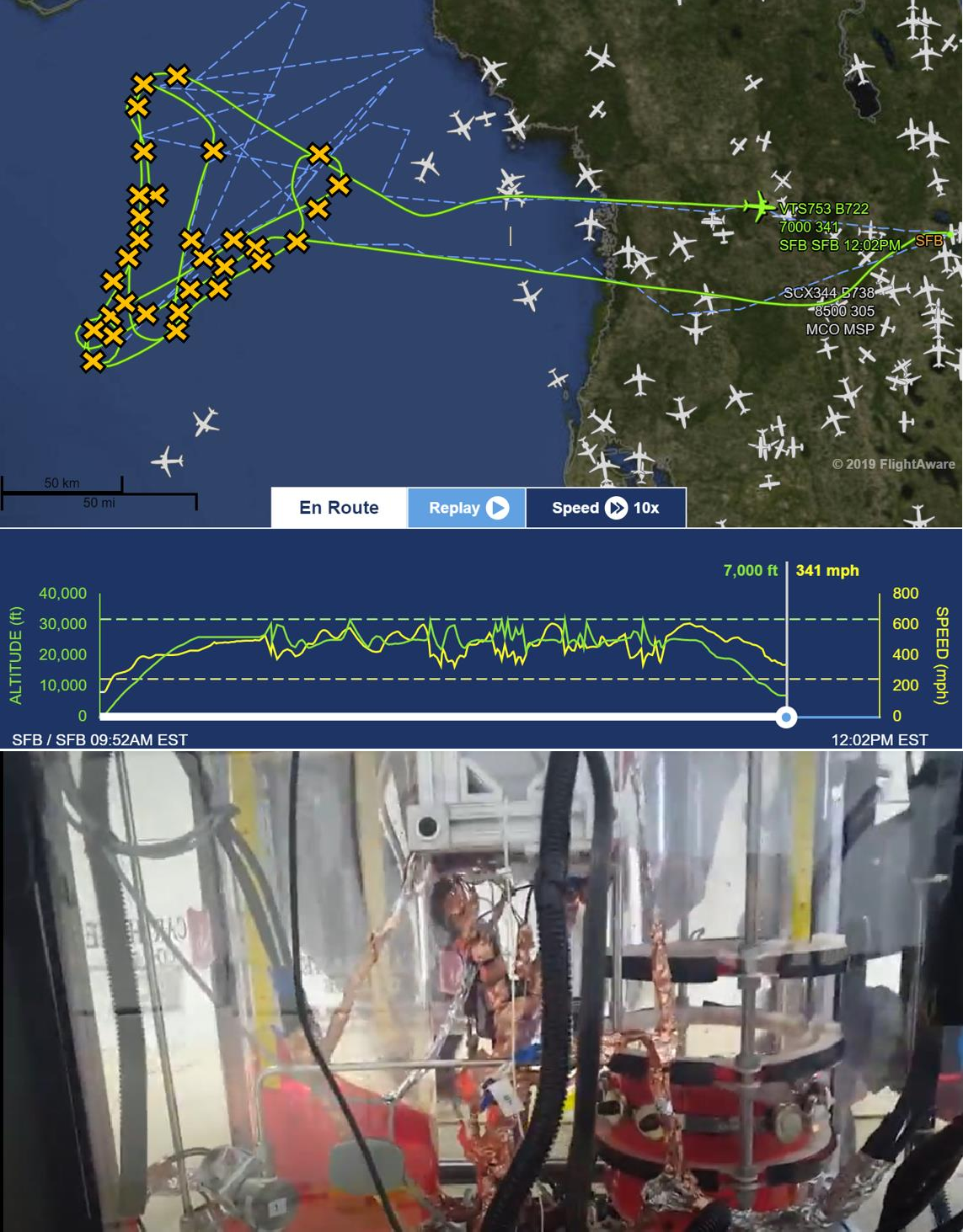
Image below: Parabolic flight November 2020
Image below: Accompanied with Carthage College and ERAU students
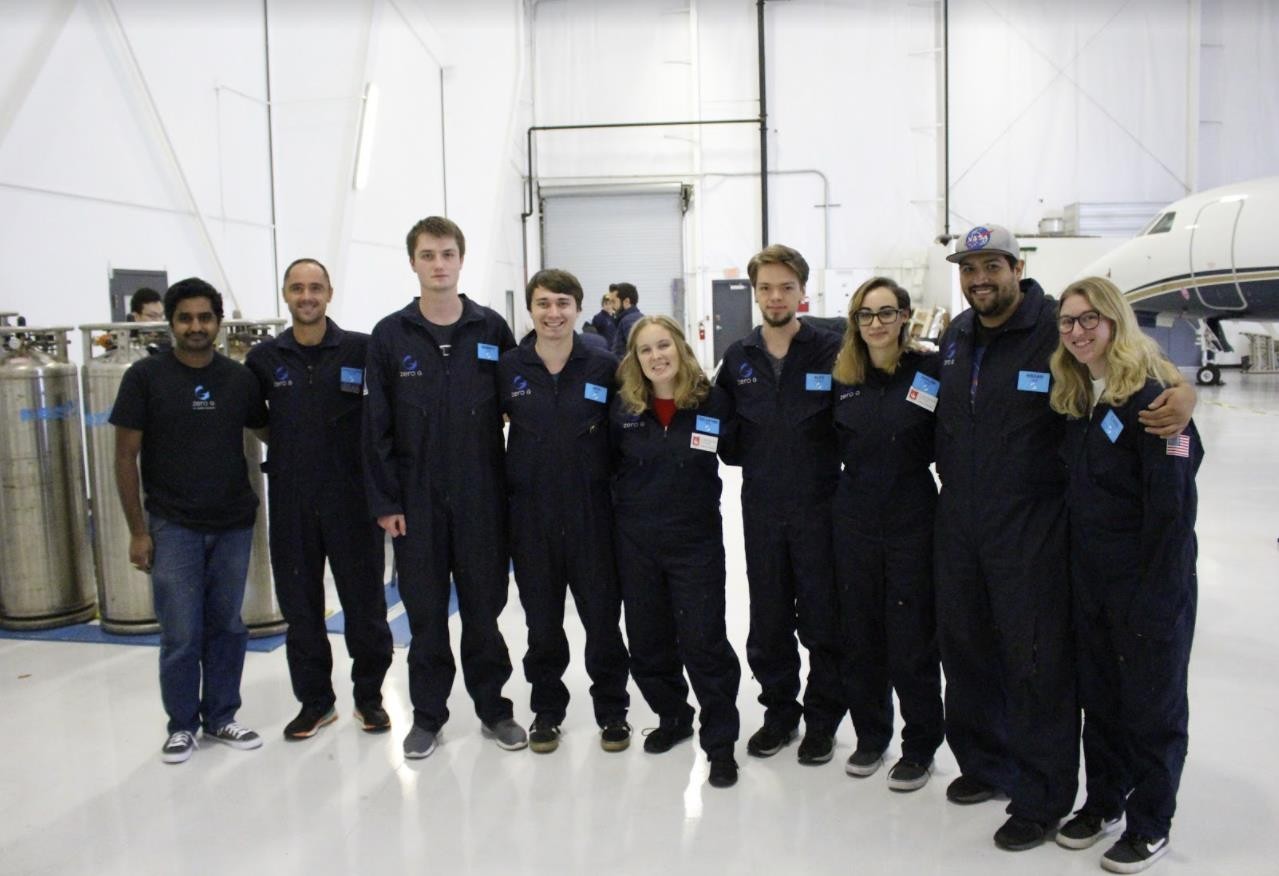
Categories: Faculty-Staff
-
Spaceports: Portals to the Universe, NASA Florida Space Grant Consortium
CO-I Kassidy Moragne
CO-I Jetro Gallo
CO-I Alexandria Cogdell
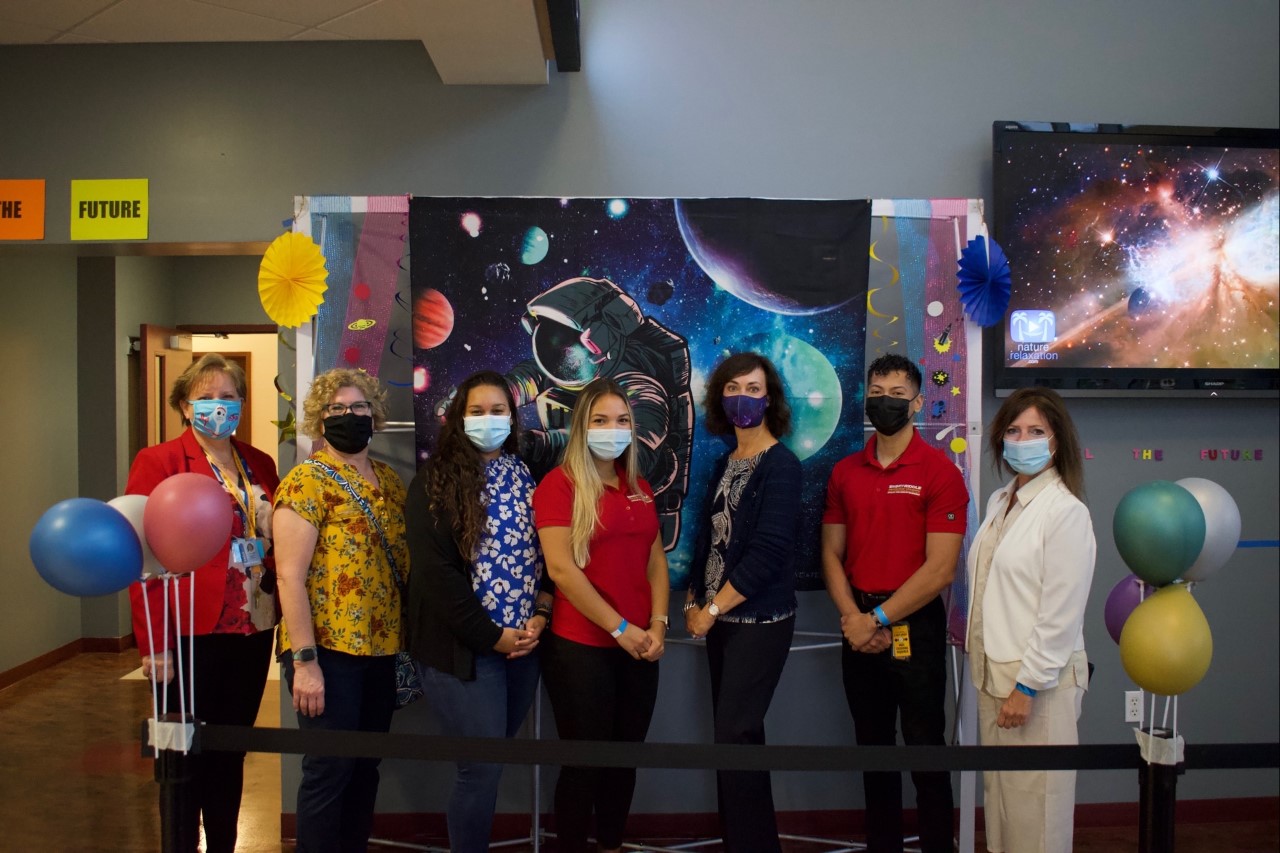
Merriam-Webster Dictionary (2020) defines a spaceport as “an installation for testing and launching spacecraft,” but spaceports are so much more than a slab or runway and represent an essential component of the entire space industry ecosystem (e.g. Tinoco, et al 2020). Without spaceports, there is no spaceflight. There are no astronauts. There are no satellites. There is no International Space Station. And there is no Artemis and no expedition to Mars.
A review of online learning resources for children, parents, and teachers reveals instructions and learning tools for wide range of topics including rockets, spacecraft, satellites, planetary and lunar land vehicles; propulsion systems; planets, moons, and solar systems; spacesuits, among others. Yet, no resources were found on spaceports and spaceport infrastructure, the very foundation of spaceflight.
The intent of this effort is to build an education curriculum on spaceports that enlightens children, teachers, and families on spaceports and the infrastructure needed to support the safe integration, launch, and return of various vehicles, crew, and payloads. Many children believe that space is exclusively the domain of astronauts, engineers, or scientists (e.g., The LEGO Group 2019). Educators and parents are often of the same mindset. But space is for everyone and the careers associated with the space economy are wide and varied. Spaceports are just one domain where many individuals contribute to the success of a space program or initiative, each a valuable member of this unique sector. The more our younger populations learn of the different areas of the space ecosystem and the associated types of jobs, the better we all will be in building and sustaining a space economy fortified by a diverse workforce. Initially, the primary beneficiaries of this effort will be local school children and teachers in the state of Florida, particularly in Volusia County and other geographic areas of the Space Coast. Our hope is to engage economically disadvantages schools (with and without STEM programs) for a pilot study, allowing for a wider audience of interests and backgrounds. Our proposed effort has garnered the encouragement of Space Florida and resource support from Space Foundation and Volusia County Public Schools (VCPS) teachers.
Tinoco, J., Yu, C., Howard, D., Stilwell, R. (2020). Introduction to Spaceports: Runways to Space, Milton Park, Abingdon, Oxon: Routledge
The LEGO Group (2019). LEGO group kicks off global program to inspire the next generation of space explorers as NASA celebrates 50 years of moon landing. Retrieved from https://www.prnewswire.com/news-releases/lego-group-kicks-off-global-program-to-inspire-the-next-generation-of-space-explorers-as-nasa-celebrates-50-years-of-moon-landing-300885423.html
Merriam-Webster Dictionary (2020) defines a spaceport as “an installation for testing and launching spacecraft,” but spaceports are so much more than a slab or runway and represent an essential component of the entire space industry ecosystem (e.g. Tinoco, et al 2020). Without spaceports, there is no spaceflight. There are no astronauts. There are no satellites. There is no International Space Station. And there is no Artemis and no expedition to Mars.
A review of online learning resources for children, parents, and teachers reveals instructions and learning tools for wide range of topics including rockets, spacecraft, satellites, planetary and lunar land vehicles; propulsion systems; planets, moons, and solar systems; spacesuits, among others. Yet, no resources were found on spaceports and spaceport infrastructure, the very foundation of spaceflight.
The intent of this effort is to build an education curriculum on spaceports that enlightens children, teachers, and families on spaceports and the infrastructure needed to support the safe integration, launch, and return of various vehicles, crew, and payloads. Although further analysis is needed, the targeted segment of the population will likely be students in grades 2 through 8 and teachers that focus on this age group. Best teaching approaches and age-appropriate topics will be reviewed with local community teachers and industry to provide a well-rounded overview of spaceports, as well as types of jobs that are prevalent. Additional topics could include propellants, communications, security/cybersecurity, transportation and storage of components, airspace use, environmental and community considerations, space policies and laws, etc. The outcome of this effort will be a “ready to go” curriculum that can be provided either in the classroom or in a spring/summer camp environment. Further, considerations will be given to face-to-face and remote instruction. Teaching materials will be developed to aid educators and will be made available for use.
Many children believe that space is exclusively the domain of astronauts, engineers, or scientists (e.g., The LEGO Group 2019). Educators and parents are often of the same mindset. But space is for everyone and the careers associated with the space economy are wide and varied. Spaceports are just one domain where many individuals contribute to the success of a space program or initiative, each a valuable member of this unique sector. The more our younger populations learn of the different areas of the space ecosystem and the associated types of jobs, the better we all will be in building and sustaining a space economy fortified by a diverse workforce. Initially, the primary beneficiaries of this effort will be local school children and teachers in the state of Florida, particularly in Volusia County and other geographic areas of the Space Coast. Our hope is to engage economically disadvantages schools (with and without STEM programs) for a pilot study, allowing for a wider audience of interests and backgrounds. Our proposed effort has garnered the encouragement of Space Florida and resource support from Space Foundation and Volusia County Public Schools (VCPS) teachers.
Tinoco, J., Yu, C., Howard, D., Stilwell, R. (2020). Introduction to Spaceports: Runways to Space, Milton Park, Abingdon, Oxon: Routledge
The LEGO Group (2019). LEGO group kicks off global program to inspire the next generation of space explorers as NASA celebrates 50 years of moon landing. Retrieved from https://www.prnewswire.com/news-releases/lego-group-kicks-off-global-program-to-inspire-the-next-generation-of-space-explorers-as-nasa-celebrates-50-years-of-moon-landing-300885423.html
Categories: Faculty-Staff
-
Iranian Proxy Groups in Iraq, Syria, and Yemen A Comparative Analysis
CO-I Hugh Sadri
After the fall of Saddam Hussein, Tehran’s leaders took advantage of Baghdad’s weak position and put many Iraqi power centers and local groups under their influence using a variety of soft to hard power instruments. After the withdrawal of coalition forces from the region in 2011 and through its proxy networks, Tehran gained a solid foothold in Iraq and Syria under the guise of helping Baghdad and Damascus fight the Islamic State. Likewise, Iranian proxy groups have backed Houthi rebels in Yemen fighting a regime dependent on Saudi Arabia for survival. Our primary research question is: How does Iran develop, employ, and sustain proxy organizations in Iraq, Syria, and Yemen, and what vulnerabilities does its regional strategy face as a result? Our objective is to analyze the role of Iranian influence in its proxy organizations across the Middle East.
This study, funded by Joint Special Operations University, offers a fresh perspective to the study of Iranian proxy organizations in Iraq, Syria, and Yemen. Our research employs a comparative analysis of Iranian proxy groups (a target of SOF Research Topics, 2019) across the Middle East. The demise of the Ba’athist Party in Iraq in 2003 created a regional power vacuum gradually filled by Iranian organizations.Categories: Faculty-Staff
-
Integrating Expanded and Non-Segregated UAS Operations into the NAS: Impact on Traffic Trends and Safety
CO-I Dothang Truong
CO-I Ryan Wallace
This research led by Richard Stansbury (PI) will provide further insight into the safe integration of sUAS through the forecasting of expanded and non-segregated sUAS operations. The ASSURE research team will collect data to inform the FAA on risk-based methodologies to develop and apply safety rules, regulations, and revised Safety Management System (SMS) protocols based on forecasted UAS operational needs and performance characteristics.
Categories: Faculty-Staff
181-189 of 189 results

